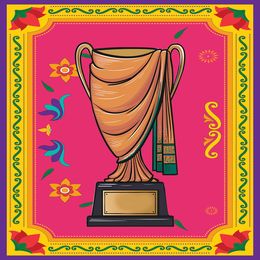Alia Bhatt wore a sari with a 23-foot train to Met Gala 2024 declaring, "there's nothing more timeless than a sari". Naomi Campbell stunned everyone at the French Riviera wearing a lavender sari. Last week, about 500 ladies in saris dazzled the Times Square in New York with a walkathon, as had many in London’s Trafalgar Square last year. Indeed, they had modest trains.
The sari has come of age, declared the fashion press after the Times Square show. Wrong! In the south, girls in pavadai used to shift to half-sari after they came of age, and graduate to sari at the time of marriage. Wondered what pavadai means? Pav = legs; aadai = garment!
The sari came of age yugas ago. Alia Bhatt knew it or not, the sari is mentioned in the Rig Veda. It is ageless; even in this metric age, it is measured in yards. A vadhyar once told me that stitched clothes are not to be worn at vedic rituals, because they have been ‘polluted’ by the touch of iron; that’s why certain temples don’t let you wear shirts. The sari—as also the dhoti, veshti or mundu—has thus survived yugas ‘unpolluted’. To each, his faith.
To look elegant, other garments have to be made well; the sari has to be worn well. In the case of other garments, the tailor maketh the woman. In the case of sari, the wearer maketh herself. To each, her garment.
When it comes to clothing, there is nothing more closely identified as Indian than the sari and the Sikh turban. Most of our lady leaders know this well—from the well-groomed Sonia Gandhi and Smriti Irani to the nearly unlettered Pramila Bisoyi who became a wife at five, and an MP at 75 after empowering the women of Ganjam to stand on their feet.
The fashion press makes much of the cloth’s length, like Lady Diana’s 25-foot wedding gown train. That’s no big deal for our mothers, sisters and daughters. They wear six-yard-long (18 feet) saris every day and everywhere—to work, on travel, in the kitchen, to parties, running after their brats or buses, and now, in the election season, chasing votes. Kalpana Soren, who used to wear all kinds of clothes, has stuck to sari since she plunged into electoral politics, even wearing a green, the JMM’s colours, to her nomination. Phoolan Devi, who wore shirts, trousers, guns and bullet belts in the Chambal, wore saris to Parliament.
The love for the sari cuts across parties. Indira Gandhi looked the Bharatiya naari with the pallu over her head at political events in India, but charmed statesmen in sleeveless blouse and dapper hair-do when abroad. Daughter-in-law Sonia took after her with starched handloom saris and long-sleeved blouses, and got into Vanity Fair's 2013 list of the world's best-dressed leaders. Sushma Swaraj looked charmingly motherly with her sari and bindi as did Margaret Alva and Jayanthi Natarajan with her Kanjeevaroms. Then there are Nirmala Sitharaman, Mahua Moitra, Dimple Yadav, Kanimozhi, Supriya Sule—some with bindi, some without—who would give our stylists and supermodels a run for their million-rupee garments when it comes to power dressing.
The leftie ladies, too, favour the sari-and-big bindi. Look at Brinda Karat, Annie Raja, Jaya Jaitley, or Subhashini Ali who throws the pallu over her right shoulder like a Gujarati behn. Not to talk of Mamata Banerjee who wears her whites-with-borders carefully clumsily, and makes a style statement much like Mother Teresa’s.
Indeed, many have spurned the sari and yet walked the power ramp in style—Mayawati for one. She wouldn’t be caught in a sari, even for a million votes.
To each, her style.
prasannan@theweek.in


